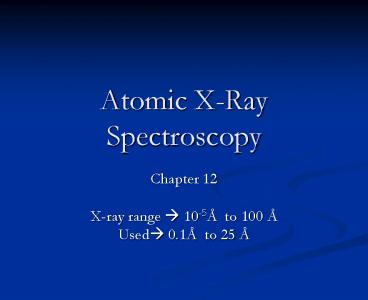Atomic X-Ray Spectroscopy - PowerPoint PPT Presentation
1 / 19
Title:
Atomic X-Ray Spectroscopy
Description:
Atomic X-Ray Spectroscopy Chapter 12 X-ray range 10-5 to 100 Used 0.1 to 25 Formation of X-Rays (emission) Produced by the deceleration of high-energy ... – PowerPoint PPT presentation
Number of Views:664
Avg rating:3.0/5.0
Title: Atomic X-Ray Spectroscopy
1
Atomic X-Ray Spectroscopy
- Chapter 12
- X-ray range ? 10-5Å to 100 Å
- Used? 0.1Å to 25 Å
2
Formation of X-Rays (emission)
- Produced by the deceleration of high-energy
electrons. - Electronic transition of electrons in the inner
orbitals of atoms.
3
Formation of X-Rays (fluorescence)
- Exposure of a substance to x-ray radiation ?
absorption and then ? fluorescence - Inner orbital electrons in K or L shells of metal
atoms are knocked out! (big or small?) - Outer shell electrons undergo transitions to the
lower shells and give off high energy X-Rays
4
Formation of X-Rays (decay, synchroton)
- Radioactive decay ? X-ray emission (common in
medicine) - Synchrotron source radiation (accelerated
particles) very few of these available!
5
X-Ray Tube (electron beam sources)
Determining the energy of the X-Ray
100KV!
Controlling the intensity of X-Ray
6
X-ray tube emission
Continuum Spectra Results from Collisions
between the electrons and the atoms of target
materials
Ee Ee h? At ?o, Ee 0 h?0 hc/?o
Ve V accelerating voltage e charge on e-
- l0 12,398/V
- Duane-Hunt Law
- Independent of material
- Related to acceleration voltage ? E
l0
7
Line spectra is possible!
From electron transitions involving inner shells
- Atomic number gt23
- 2 line series K and L
- E Kgt EL
- Atomic number lt 23
- K only
- A minimum acceleration voltage is required for
l0
L
Line Spectrum of a Molybdenum target
A minimum acceleration voltage required for each
element increases with atomic number
8
Line spectra
l0
9
Electron Transitions ?X-Rays
Question which K series appear at short
wavelength between W and Cr?
10
- Which K series appear at short wavelength between
W and Cr? - Which K series appear at short wavelength between
metal W and W oxide (W is a heavy element)?
11
Radioactive sources are more common
12
X-ray absorption
Ln P0/P µX µ is the linear absorption
coefficient is characteristic of the Element and
of atoms in the path of the beam. X is sample
thickness Ln P0/P µM?X ? is density of the
sample µM is mass absorption coefficient
13
Braggs Law of Diffractionlight scattering by
lattice of atoms!
Constructive interference only at angles
proportional to l and d! If l is known and q
can be measured then you can calculate d! If d is
known and q can be measured then you can
calculate l!
14
X-Ray Monochromator (diffractometer?)
15
X-Ray Diffraction Spectrum
16
Debye-Scherrer Powder Diffractometer (Camera)
17
X-Ray Spectra of Polymorph 1
18
X-Ray detectors
- Geiger tube formation of ions and electrons from
an inert gas kept at 1200-1600V - Phosphors (Scintillation counters) fluorescence
of ZnS when hit by a particle - Semicoductor detectors based on a modified diode
19
(No Transcript)































